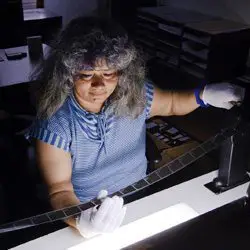“Conventional data backup is not a preservation process”

Why the microfilm conversation continues
A few days ago, I posted this comment to several relevant Linkedin groups:
“Interesting headline in USA Today, but misleading as the archives and records management industries agree that microfilm remains relevant as a preservation media.” The rest of the comment then pointed to a prior blogpost I’d written on why microfilm remains important today. The headline itself mentioned “a major fight over microfilm” when in fact the discord is over client base and not the microfilm medium.
Surprisingly – this is microfilm in the week of the Kardashian-West nuptials – the discussion has remained popular for the past two weeks (by Linkedin definition, anyway).
Why does the conversation over microfilm remain strong?
My best guess is that group members – archivists, records managers, librarians, service bureaus and others in the field – understand just how tenuous “permanent” really is. This was reiterated in a comment to my post made by Jim Harper, president of PFA, Inc., a west Coast service bureau. A friendly Crowley Imaging competitor, PFA and Crowley are in complete agreement when it comes to microfilm.
“Just a few thoughts on your piece about the value of microfilm in the records management industry.
At PFA, we have been supporters and promoters of microfilm for a very long time.
There is…an emerging ‘born digital’ generation who are going to be less sympathetic to traditions that may have served us well but just do not appeal to them. We can and do need to make them aware of the importance of records preservation but we’ll need to do it in a framework that resonates with their experiences and expectations. And we need to do this while microfilm is available as a complementary technology.
There are emerging content management technologies that address the principles and processes necessary for electronic data preservation. As state governments update their statutes to accommodate the benefits of electronic records management, microfilm is often eliminated from the equation. When this happens, the question should be asked, “What system and/or process is going to replace it?”
An important message here is that conventional data backup is not a preservation process. It typically moves data from one place to another without regard to its condition, authenticity, validity, or accessibility. Without an audit process in place, bad data in a records management system will merely be replicated in the backup system.”
Jim goes on to give suggestions as to how an electronic preservation process might take place; it includes hashing algorithms, constant monitoring for existence, authenticity and trustworthiness and a recovery plan. His point is that it’s possible, but it’s not simple. And it all hinges on the fact that electronic storage is permanent.
Is it?
We agree with Jim that those of us in the industry need to be sure that microfilm is not eliminated as an option from the preservation equation. There is much merit to the “hybrid” approach of preservation and disaster recovery – a blending of old and new technologies. Digital preservation is effective for “near-line” or “online” storage and when immediate access is critical or preferred. When true preservation and back-up for disaster recovery is paramount, microfilm – the “offline” storage medium with a 500-year shelf life – is essential and should be a critical piece to any organization’s overall preservation.
By the very nature of our business model, The Crowley Company is fully invested in the hybrid approach. We recognize that today’s world is digital; we both manufacture and resell scanners that provide access to many of the world’s treasures online. By the same token, we have not given up our analog roots and continue to offer microfilm, micrographic services and equipment that write digital files to microfilm for long-term preservation.
Come to the light
Still a relative “newbie” to the industry after six years, I keep coming back to what I learned my first day on the job: if you hold microfilm up to the light, you can see the image.
No electricity needed.
From my vantage point, that’s about as close to permanent as you can get.
QUESTIONS ABOUT MICROFILM OR PRESERVATION?
If you have any questions about the continued importance of microfilm as a preservation media or would like quotes on microfilm, microfilm scanners, archive writers or microfilm digitization, please contact the Crowley Company by calling (240) 215-0224. General comments and inquiries can be emailed to [email protected].

